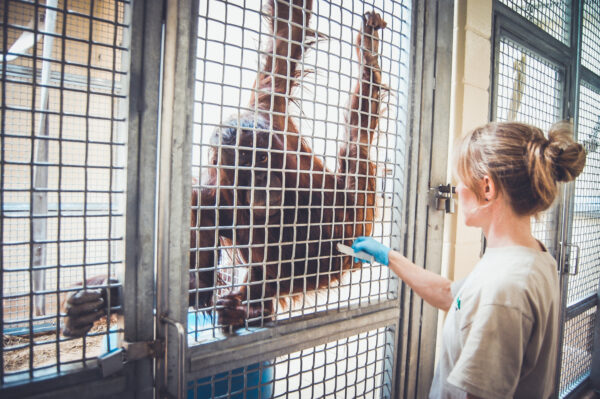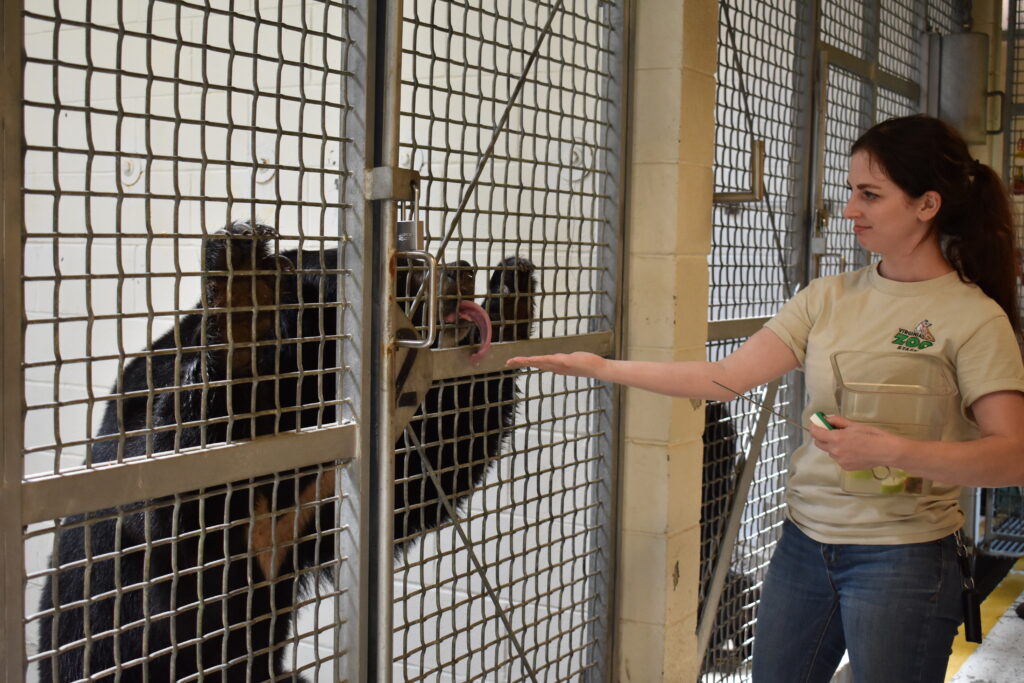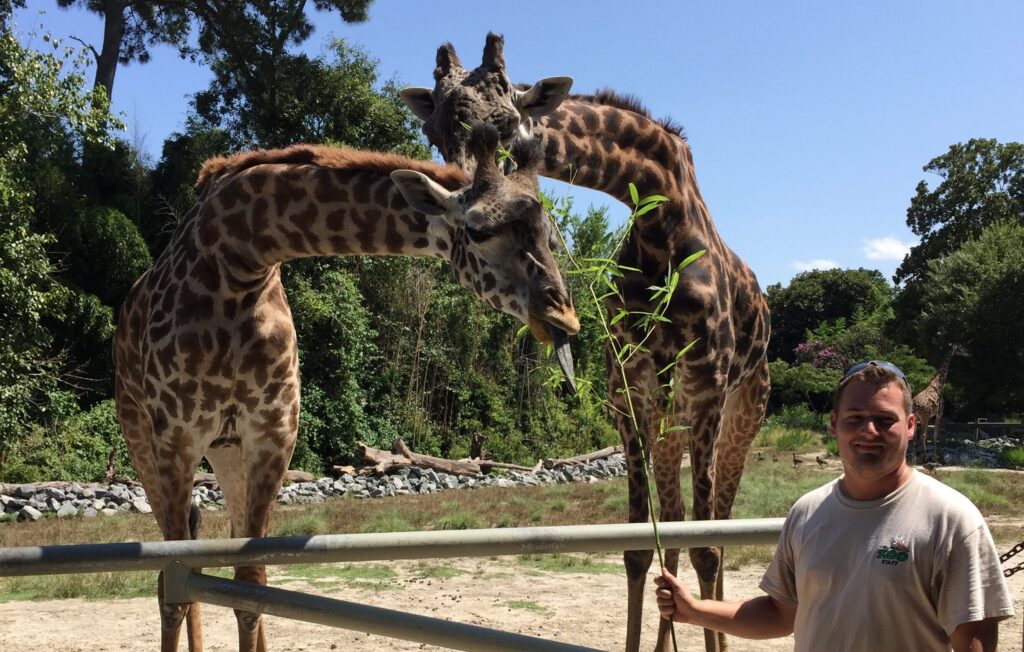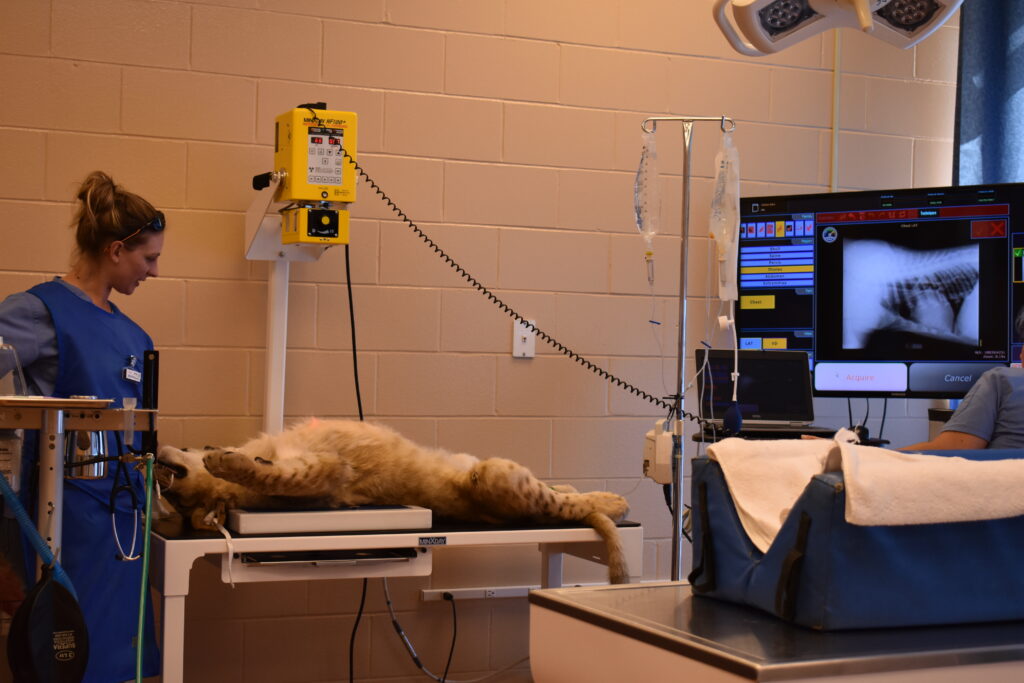Training Makes Vet Visits Easier
Just as humans visit their doctors for routine check-ups, animals at the Virginia Zoo are also visited by their doctor, or veterinarian Dr. Colleen Clabbers. To prepare for routine check-ups, many of the animals are trained to voluntarily participate in their own medical care to help make the process easier, safer and less stressful on both the animals and their caretakers.
Our Zoo Keepers work with the animals daily, with animal training and enrichment making up a regular part of their daily routine. Using positive reinforcement, Keepers can train animals to do voluntary husbandry behaviors that allow them and vet staff to provide the best possible care. And with regular training sessions that are positive and motivating, visits from vet staff can even be fun for the animals!

Voluntary husbandry behaviors we train at the Zoo include:
- presenting different parts of the body for visual exams so staff can observe any abnormalities, sores, cuts, etc.
- stepping onto a scale to be weighed to monitor weight gain or loss
- opening mouths for oral exams to check for wounds, signs of gum disease, broken or abscessed teeth, cavities or plaque buildup
- allowing an ultrasound probe to touch a pregnant belly or other body part
- allowing routine nail, beak or wing trims
- entering and being comfortable in a crate, kennel or chute to allow for transport or exams
- allowing blood to be drawn and injections to be given (for vaccinations, medications or sedatives before an anesthetic procedure)

Training for voluntary husbandry behaviors typically involves using the same or similar tools to what is used during an actual vet visit. For example, when training an animal to voluntarily have blood drawn, the Keeper doing the training may first get the animal comfortable with a syringe with no needle being presented and eventually touching them. Once comfortable with that step, the Keeper may then add on a blunted needle to the syringe that simulates the pressure of a needle, but doesn’t actually pierce the skin. After the animal is comfortable with the extra stimuli, staff may move to using an actual needle and can then try to draw blood. Throughout the training process, the animal is reinforced for each approximation (or step) until eventually they are reliably doing the requested behavior when asked. Reinforcement can be anything the animal likes, such as a favorite food or enrichment item, or for animals that are very tactile, a rub or scratch can be reinforcing as well.

Training sessions are always voluntary for the animals, and it is part of the Keepers’ job to find out how to make training sessions fun and motivating. Since participation is ultimately decided by each animal, there is no set amount of training time. Each animal and behavior being trained is always a little different, and staff learn what works best for each animal. When there are times that an animal doesn’t do a behavior or participate in a training session, Keepers may just take a break and try again at another time. Staff will try to figure out why the animal didn’t do the behavior or participate and may adjust how they approach it the next time to better set the animal up for success.
When staff are working with the animals it is important to note that some of the animals at the Zoo are species that people do not go into their enclosures with for safety reasons, such as any of the big cats, apes or bears. When Keepers or Vet staff interact with these animals, they work in what is called a protected contact setting; staff still do training with the animals, but may need to be creative and figure out ways to train the behaviors wanted while working with a safety barrier between staff and the animals.
Most of the animals at the Zoo are on a vaccination schedule, so our vet staff plan that out in advance and Keepers can often train the animals to voluntarily participate. If it is an emergency illness or injury, staff can ask for already-trained behaviors that allow examination; however, if the animal is ill or injured to the point where they can’t participate in a trained behavior, vet staff may need to sedate the animal for further assessment in the interest of the animal’s health.

Training the animals for these behaviors can make visits from the Vet easier, but Vet staff also know that simply visiting the animals on a regular basis can be just as important. Dr. Colleen and the Zoo’s Vet Technicians do try to visit many of the animals regularly outside of needed vet visits, both to keep them comfortable with having vet staff around and to stay on top of how the animals are doing.
Not only are routine physicals and visits from the Vet important, but training the animals to voluntarily participate in their own medical care is one of the most important things we can do to help keep them healthy and thriving.